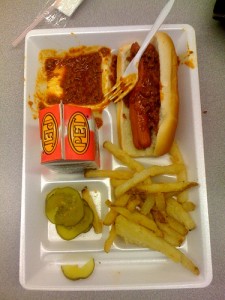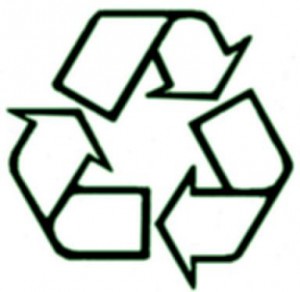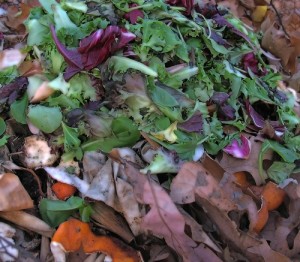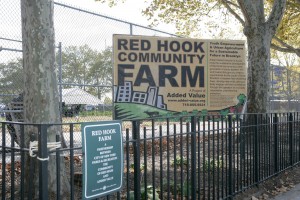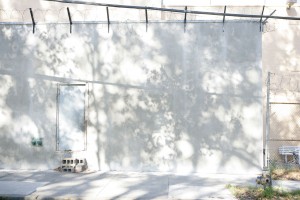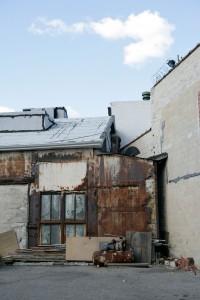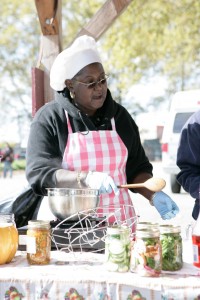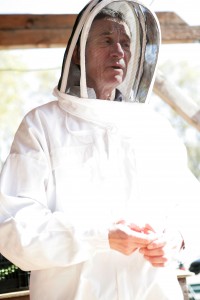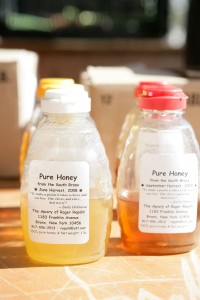Here’s a site where you can take a simple and fun quiz to test your composting knowledge. It takes less than a minute and might give you some information you didn’t already know.
Tag Archives: composting
School Lunch
This photo is pretty much what a school lunch in New York City public schools looks like. Complete with styrofoam tray. An estimated number of 1.2 million schoolchildren in New York’s 1400 public schools eat their lunches using those trays. Some children bring their lunches, of course, but others also get breakfast at school on those trays. So that means that probably a million styrofoam trays are tossed into landfills each school day. It’s horrifying to keep going with the math on that one.
I did see a shining beacon of hope that change might come to the schools. I toured The Brooklyn New School yesterday. It’s a magnet school started by some hippie parents in the 80s. Besides all of the hands-on programs they offer the students, they also organize a CSA (community supported agriculture) and they compost the student’s lunches. Yes, you heard that correctly. The students sort their food into compostable and non-compostable food. They have a big compost bin that generates a lot of heat, and they use the soil. I think they said that they have reduced the food waste by 80%. Isn’t that amazing??? Very inspiring. I’m not sure Lindsay will go to that school, but if she doesn’t, I think I will try and use their model to start a composting program at her school.
Today is America Recycles Day
Saturday is America Recycles Day; Recycle, reduce greenhouse gas emissions / U.S. EPA encourages public to do its part, find ways to increase recycling
Contact Information: Wendy Chavez, 415/947-4248, chavez.wendy@epa.gov
(11/14/08) (SAN FRANCISCO) — Trash can or recycling bin? It’s your choice. As America Recycles Day approaches, the U.S. Environmental Protection Agency encourages people to think about increasing their recycling rate to conserve resources and reduce greenhouse gas emissions.
November 15 marks the eleventh anniversary of America Recycles Day, a day dedicated to encouraging Americans to recycle and to buy recycled products. More than 35 states are holding America Recycles Day events, with state and local governments, non-profit organizations, and large industry partners promoting recycling efforts. America Recycles Day is supported by the National Recycling Coalition and sponsored by the U.S. EPA.
“Recycling is a great way all Americans can help fight global warming and protect the environment,” said Jeff Scott, the EPA’s Waste Division director for the Pacific Southwest region. “On America Recycles Day, we encourage everyone to learn about opportunities to do even more.”
The EPA’s new 2007 Municipal Solid Waste Characterization report shows Americans recycled and composted 85 million tons of the 254 million tons of total municipal solid waste produced in 2007. Each person produced on average 4.6 pounds of trash per day. Recycling increased slightly over 2006, when people recycled and composted around 82 million tons of the 251 million tons of total municipal solid waste produced.
Opportunities to increase recycling include:
University student recycling competition: This month RecycleMania opens registration for colleges and universities to compete on their waste reduction and recycling efforts. In this 2009 national competition, schools can be recognized for the highest recycling rate or the largest amount of recyclables per capita. During the 2008 competition, 58.6 million pounds were recycled and composted, preventing the release of 25,342 metric tons of carbon equivalent greenhouse gas emissions — the equivalent to eliminating the annual impact of 15,439 passenger cars; the electricity use of 11,165 homes; or the burning of coal for 440 railcars.
Go beyond recycling – compost: In addition to paper, bottles and cans, recycling also includes composting food and green waste. About 25 percent of what is still sent to landfills is food and green waste that can instead be composted and turned into a beneficial soil amendment and great nutrient in your garden.
Recycling certification training: To learn more about recycling, the California Resource Recovery Association is offering a professional certification training program this year. The training, partially funded by a U.S. EPA grant, provides classroom courses, testing, and guidance on how to implement a recycling or composting program. Recycling provides economic benefits by reducing costs to businesses and creating jobs. The American recycling and reuse industry is a $200 billion enterprise that involves more than 50,000 recycling and reuse establishments, employs more than 1 million people, and generates an annual payroll of approximately $37 billion.
For more information on America Recycles Day, visit:
http://www.nrc-recycle.org/americarecycles.aspx
For more information on RecycleMania, visit:
For more information on composting, visit:
http://www.epa.gov/region09/waste//organics/index.html
For more information on Recycling Professional Certification:
http://www.crra.com/certifications/index.html
Compost 101
A lot of people are very interested in composting, but find the process too intimidating. With a few pointers, it’s really very simple. In this lesson I will assume that you have an outdoor space for your compost. We will have a lesson in composting indoors coming up shortly.
How do leaves, berries and other organic matter turn to soil (or compost) in nature? They get rained on and start to decay. What’s the difference between breaking organic matter down at home versus in the wild? Nothing much just some time and energy. If you have a big yard, you can have one or more piles in an out-of-the-way area and let nature slowly break them down. This process could take a year or more depending on what you put on the pile. However, many people don’t have that kind of space or patience.
So let’s assume you have some outdoor space and want a contained pile that will produce rich compost more quickly. There are many online sources to find compost bins. Many cities have compost programs in which they give or sell (at reduced prices) compost bins. This is mutually beneficial because while you get a free or inexpensive compost bin, they don’t have to haul away as much garbage. About 60% of everyone’s garbage consists of organic matter that could be composted. It’s a shame to throw this into a landfill when you could turn it into rich soil for your plants. The New York Sanitation Department has a partnership with the Brooklyn Botanic Garden to subsidize compost bins and classes. This wonderful project is facing the axe of budget cuts unfortunately. The bins are still less expensive than many commercial sites. If you live in the NYC area, you can email them for information about purchasing their bins at compost@bbg.org.
Some online sources for compost bins:
Or, you could build your own:
- Take a galvanized trash can and punch holes in it. This compost bin is the best solution if you are at all worried about attracting rodents.
- Or follow the directions on this website, which shows several different types to build.
The most important thing to remember in the beginning is that the organic material you toss in your compost bin will eventually turn into compost no matter what. Short of shellacking your leaves, there’s really nothing to prevent them from breaking down into soil, so don’t worry about messing up the process. They are going to decay and break down without you, so you don’t need to dig into the nitty gritty too much to compost. If you are type-A like myself, you will want to know about the bacteria and fungi that are involved with the process, but let’s keep things simple for now. We want to get you started and help prevent some common problems.
There’s a whole list of things that you can put into your compost pile, but let’s first talk about what should not go in.
DO NOT ADD:
- Meat or Fish – This will stink and attract rodents.
- Dairy
- Oily foods – Oil coats the food preventing the bacteria from getting to the food and doing their good work.
- Pet feces -Dogs, cats and other meat-eating animals carry a host of diseases that won’t break down in a backyard pile. Some cat litter says it’s compostable and it is if there’s only urine in it. But maybe you shouldn’t even go there.
- Inorganic/manmade materials – Rubber bands, metal twist ties, plastic, metal or anything that will last on the planet longer than our grandchildren.
GOOD TO ADD:
The short answer for what to put in is basically everything else and some water. You can certainly make compost with this much information. The stuff that follows just adds a bit of information to make your scraps turn into soil faster and avoid smells. I’m breaking the good stuff into two parts: green and brown.
Add GREEN materials such as:
- Vegetables
- Fruits
- Grass clippings
- Animal manure – From non-meat eating animals such as horses or chickens. Chicken poop is very high in nitrogen, which makes it an excellent choice
- Coffee grounds
- Bread
- Old flowers
- Weeds – Avoid weeds that have gone to seed as they will flourish in your compost and then grow wherever you spread it in your garden.
Add BROWN materials such as:
- Leaves
- Egg shells
- Sawdust
- Tree branches – Avoid ones that are too big as they will clog up your pile for a very long time.
- Unbleached napkins and paper towels
- Newspaper
- Wood ash – Ash from charcoal shouldn’t be used.
- Lint from the dryer or vacuum cleaner bag
Green materials have a lot of nitrogen in them, which helps them decay faster, but can smell in the process. Brown materials have a lot of carbon in them and take longer to decay, but don’t smell. Try to mix some green materials with some brown materials to give you the best of both worlds. You generally want slightly more browns (60%) than greens (40%), but don’t lose sleep over the ideal proportions. If your compost bin is smelly, add some more material from the brown list.
After you’ve added your kitchen and yard scraps you should add some water and mix everything up. You can use a pitchfork or a more specialized comport crank. I use a compost crank that looks like a giant corkscrew. The ideal wetness of a pile is often described as being as wet as a wrung out sponge. You can decide how often you want to add water and turn the pile. The more often you do, the faster the process will be. But if you go away on vacation, you don’t need to find a compost sitter. The pile will continue to decompose on its own. There are products on the market that claim that they will speed up the process so much, you will have finished compost in 14 days. That’s a bunch of snake oil as far as I’m concerned.
Well, that’s pretty much it. You should have beautiful rich garden soil in about 3-6 months. You will also find plenty of earthworms and other little creepy crawlies. They are big helpers in the process and shouldn’t be seen as pests. When you sprinkle the finished compost on your garden, they will only help to enrich the soil. Have fun with your composting. Spread the word. And bask in the knowledge that you are doing a big part in making your part of the world greener and healthier.
Red Hook Harvest Festival
This Saturday our friends who moved to CT came down and we all went to the Red Hook Harvest Festival at the Added Value Farm, which is a farm my friend Alison started as part of her work for Heifer International. For anyone who isn’t familiar with Red Hook, Brooklyn it is a very urban area.
It was a beautiful day and the turnout was great. There were informational booths on composting and building rain barrel systems, there was food from Rice, there were chickens from the Red Hook Poultry Association, there was an area for costumes and face painting. Lindsay’s friend Mason dressed himself up and had his face painted as an asparagus. He was obviously inspired by his surroundings, because this is a kid who barely touches vegetables!
I caught the tail end of a canning workshop by an amazing woman named Classie Parker. I definitely have to track her down because she was extremely knowledgeable and a total riot.
A man named Roger Repohl gave a talk on urban beekeeping. He keeps bees at a community garden in the Bronx and shared a lot of his knowledge. He brought his honey and let us sample it. The honey was divided up by times of the year. The earliest honey was a pale lemon yellow and the latetest honey was a dark amber color. I liked the honey on both ends of the growing season best. The early honey was delicious with a subtle minty taste. Roger said that it was from the bees gathering nectar from Linden and basswood trees. The honey from the end of the summer had a very fruity flavor. The honey from the middle of the summer tasted more like regular honey that you get from the store. I’ve tried honey from bees that pollinate various plants, such as lavender or clover, but it was interesting to taste the difference of honey based on what the bees find in the Bronx at different times of the growing season.

